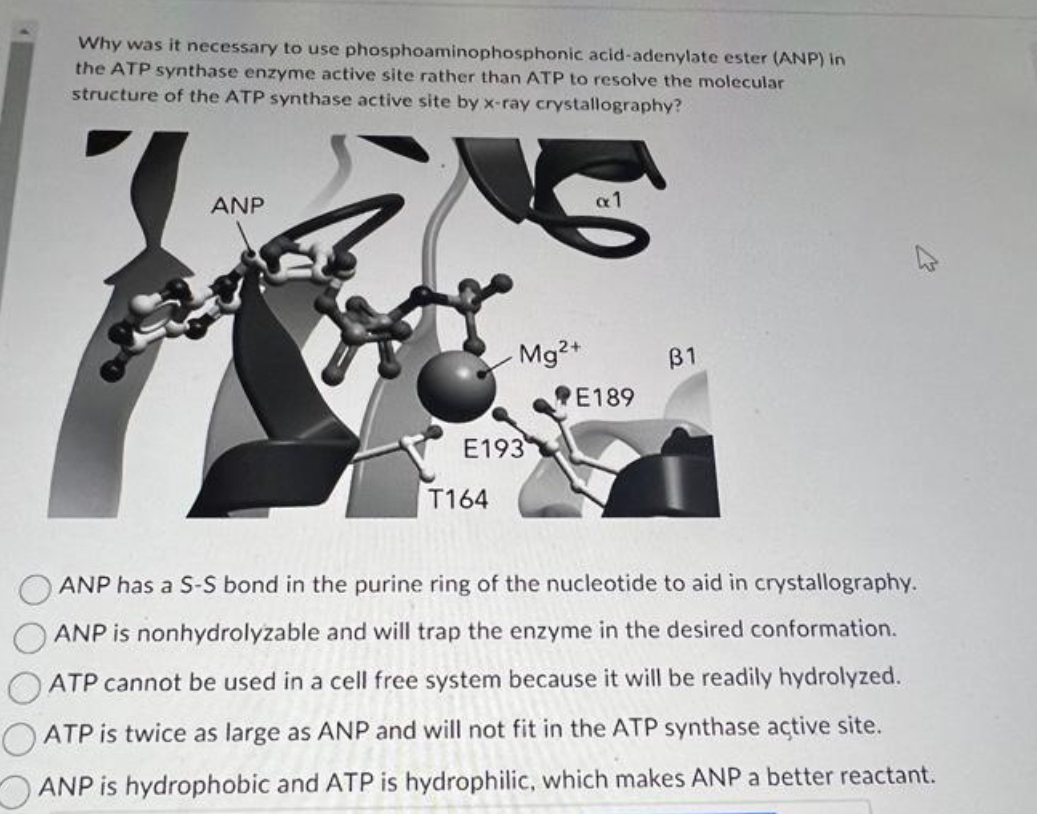Why was it necessary to use phosphoaminophosphonic acid-adenylate ester (ANP) in the ATP synthase enzyme active site rather than ATP to resolve the molecular structure of the ATP synthase active site by x-ray crystallography? C ANP - Mg²+ E193 T164 E189 31 K ANP has a S-S bond in the purine ring of the nucleotide to aid in crystallography. ANP is nonhydrolyzable and will trap the enzyme in the desired conformation. ATP cannot be used in a cell free system because it will be readily hydrolyzed. ATP is twice as large as ANP and will not fit in the ATP synthase active site. ANP is hydrophobic and ATP is hydrophilic, which makes ANP a better reactant.
Why was it necessary to use phosphoaminophosphonic acid-adenylate ester (ANP) in the ATP synthase enzyme active site rather than ATP to resolve the molecular structure of the ATP synthase active site by x-ray crystallography? C ANP - Mg²+ E193 T164 E189 31 K ANP has a S-S bond in the purine ring of the nucleotide to aid in crystallography. ANP is nonhydrolyzable and will trap the enzyme in the desired conformation. ATP cannot be used in a cell free system because it will be readily hydrolyzed. ATP is twice as large as ANP and will not fit in the ATP synthase active site. ANP is hydrophobic and ATP is hydrophilic, which makes ANP a better reactant.
Biochemistry
6th Edition
ISBN:9781305577206
Author:Reginald H. Garrett, Charles M. Grisham
Publisher:Reginald H. Garrett, Charles M. Grisham
Chapter26: Synthesis And Degradation Of Nucleotides
Section: Chapter Questions
Problem 14P: The Energy Cost of dTTP Synthesis (Integrates with Chapter 20.) Starting from HCO3, glutamine,...
Related questions
Question
Hw.9.

Transcribed Image Text:Why was it necessary to use
phosphoaminophosphonic
acid-adenylate ester (ANP) in
the ATP synthase enzyme active site rather than ATP to resolve the molecular
structure of the ATP synthase active site by x-ray crystallography?
ANP
Mg²+
E193
T164
E189
31
ANP has a S-S bond in the purine ring of the nucleotide to aid in crystallography.
ANP is nonhydrolyzable and will trap the enzyme in the desired conformation.
ATP cannot be used in a cell free system because it will be readily hydrolyzed.
ATP is twice as large as ANP and will not fit in the ATP synthase active site.
ANP is hydrophobic and ATP is hydrophilic, which makes ANP a better reactant.
Expert Solution
This question has been solved!
Explore an expertly crafted, step-by-step solution for a thorough understanding of key concepts.
This is a popular solution!
Trending now
This is a popular solution!
Step by step
Solved in 2 steps

Recommended textbooks for you

Biochemistry
Biochemistry
ISBN:
9781305577206
Author:
Reginald H. Garrett, Charles M. Grisham
Publisher:
Cengage Learning

Biochemistry
Biochemistry
ISBN:
9781305577206
Author:
Reginald H. Garrett, Charles M. Grisham
Publisher:
Cengage Learning